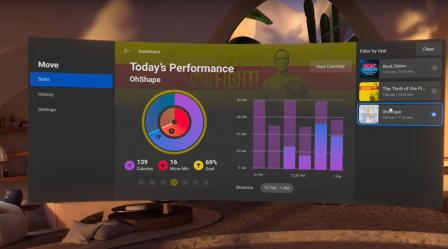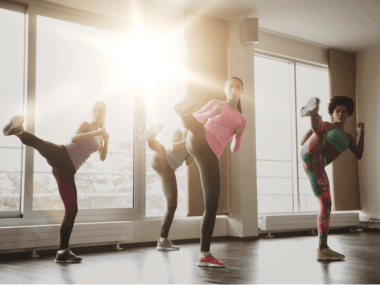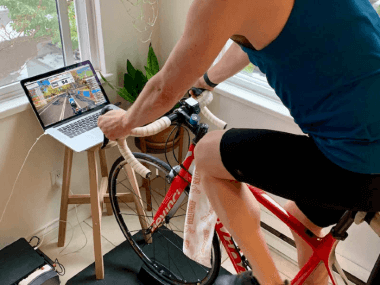Can You Get Fit in Virtual Reality?
Can virtual reality games encourage fitness? Get-Fit Guy tested the new Oculus Quest 2 to learn more about VR and fitness. He had fun, but did he break a sweat?
When I woke up this morning, I was raring to go. I made a cup of coffee while doing my morning “Get Moving” routine. Then I headed out for a walk. I took in some fresh air and sunlight, got my blood pumping, cleared my head, and set my intentions for a movement-filled day.
I love being outdoors, so getting outside in the morning is kind of my thing. But, like many people, I find that opportunities to keep moving my body drop off in the evening hours. And that’s the perfect time to strap on a virtual reality (VR) headset and have fun moving as I play some games.
What is virtual reality gaming?
Without getting too geeky, VR is a type of computer simulation where a person can experience a three-dimensional environment. In VR gaming, players interact with that environment to solve puzzles, complete tasks, battle virtual monsters, or explore.
Generally, the gear required to enter a VR world is a headset (or very large goggles) and two hand controllers, usually with multiple buttons and joysticks. Once you put on the headset, the real world is all but blocked out and you’re visually immersed in a 3-D world. With the help of the hand controllers, you can move around the world in all directions, use tools, and interact with elements you find there.
I have to admit that before I received the headset from Oculus (a brand of Facebook Technologies, LLC) I assumed VR games were gimmicky and cheesy. But I was dead wrong. After a few weeks of playing, I am still blown away by how cool and immersive gaming can be using the Oculus Quest 2.
A quick disclaimer! Facebook Technologies, LLC gave me a free Oculus Quest 2 headset to review. They didn’t make any attempt to influence my review or encourage a positive review.
How fitness and VR go together
Gamers have gotten a bad reputation for being snack-food-eating, energy-drink-swilling nerds who live in their mom’s basements far beyond an acceptable age. And while that stereotype isn’t universally accurate (check out the top gamers in Korea and you’ll see some stylish, slick, and well-to-do youngsters), it’s not hard to see why it exists. I mean, sitting on your butt in front of a gaming console or monitor for hours on end isn’t exactly the path to optimal health and wellness.
That’s where VR gaming flips the stereotype on its head.
First of all, to succeed at the majority of VR games, you’ll need to stand. That’s a win right there. (As I’ve mentioned before, I swapped my traditional desk for a standing or dynamic workstation years ago to help me have a less sedentary work life.)
Second, I have yet to witness anyone who can stay calm and still while playing in the virtual world. Limbs fly, heads duck and weave, squats and lunges happen, and an inevitable sweat is broken.
The Beat Saber example
Let me explain how VR games get you moving using what is arguably the most popular and well-known VR game—Beat Saber. It’s a game so popular that Jimmy Fallon had Brie Larson play it on his late-night tv show.
In this game, three-dimensional cubes fly toward you in various combinations, speeds, locations, and orientations and you must slice them in half with your two lightsabers. There are markers on the cubes that tell you which way to slice them. Occasionally, there are walls and obstacles you must also dodge. All the while, music provides the beat that you must slice in time with.
Watching someone play this game is not pretty. Nevertheless, I’ll humble myself and embed a video of me below so you can see how much of your body gets involved when you play Beat Saber. It truly is a frantic, and somewhat violent, full-body dance.
What does science say about VR gaming and fitness?
Even the games that are less frantic still encourage you to move your body in ways you probably don’t, at least not on a regular basis. This brings me to the hand-eye coordination and reaction time benefits of playing in a virtual world.
There’s evidence that mobile game-based VR programs effectively promote upper extremity recovery in patients with stroke. Studies have also shown that VR can be used to enhance the effects of conventional rehabilitation therapies. Other studies have found that VR and physiotherapy may have similar effects on gait, balance, and quality of life for people with Parkinson’s.
And the studies have really just started. Personally, I know my reaction time has benefited. And this nearly 50-year-old has only been playing for a few weeks!
VR is encouraging fitness
The reason I was drawn to Oculus, in particular, was because of their focus on movement and fitness. On their official blog, they have a workout of the week section, where they highlight games that have a full-body focus, arm focus, leg focus, and so on.
The Oculus Quest 2 also has a movement tracker that helps you keep track of the calories you burn and how long you’ve been physically active across any game or app in VR. You can set goals for yourself and track your progress over time.
Can you trust the Oculus calorie tracker?
By Oculus’s own admission, the amount of calories burned are roughly estimated through an algorithm that considers your basal metabolic rate (BMR) along with your headset and controller movements.
Your BMR is calculated based on your age, weight, height. and sex. I have to say, the estimates in terms of calories burned are wildly different from what my Apple Watch estimates based on those same variables.
They should have called them “movement points” instead of “calories” and made the goal to hit a certain number or more each day.
But in the end, who cares? They should have simply called them “movement points” instead of “calories” and made the goal to hit a certain number or more each day. In fact, I’m going to write a letter to Oculus right now. Who’s with me?
But before we start that revolution, let’s look at some games.
Fitness-focused VR games
I’ve already mentioned Beat Saber (which is my fave), but there are a bunch of other games that will help get you moving.
Action games include FitXR Dance, Supernatural, Synth Riders, Echo VR and Pistol Whip. There are also rock climbing games like The Climb. If you enjoy boxing, you’ll like Thrill of the Fight, and Creed. Mindfulness games like Guided Tai Chi and TRIPP can help you get centered. There are even games like HoloFit that you can play while you ride your stationary bike or do indoor rowing.
According to Grand View Research, the global virtual reality gaming market size was valued at USD 11.56 billion in 2019 and is expected to grow at a compound annual growth rate (CAGR) of 30.2% from 2020 to 2027. That means we’re likely to see more and more VR fitness games coming to market.
The downside (literally) of VR
Now that I’ve highlighted the ways VR can get the body moving, I’d be remiss if I didn’t also highlight how it basically stopped me from moving my body at all.
A very cool feature of the virtual world is that you can share experiences with friends. One way to do that is to use apps like Big Screen to watch movies and TV shows with friends all over the world. Two Saturdays in a row, I’ve watched hockey games with friends in a virtual home theater while chatting and catching up, which was amazingly fun.
But unlike watching a hockey game on TV, where you’re free to safely move around, stand up, do some floor yoga, and wander off into the other room unencumbered, wearing a VR headset really does encourage even an active mover like me to stay put. It took an urgent call of nature before I was compelled to remove the headset and skedaddle off to the washroom.
So, playing virtual games in a standing position can encourage you to move 100% of your body 1000% more than playing a traditional video game that keeps you on the couch. But watching a movie, TV show, or sporting event while wearing a headset puts a large barrier between you and the free-moving world.
The Get-Fit Guy verdict on virtual reality fitness
As my listeners know, I’m all about moving your body more often, and in more and more interesting ways … and having a blast doing it. Virtual reality accomplishes that by making movement fun and immersive. Time flies when I strap on the goggles. In fact, I often have to take the headset off or put down the controllers because I’m getting uncomfortably sweaty. But hey, I’m getting my sweat on!
The same issues I have with saving your movement practice for the gym, studio, or a certain time of day, piece of equipment, or even a particular outfit still exist with VR. Sure, incorporate VR into your fitness routine if you find it fun and it gets you moving. But remember, it’s still important to consider what you do with the rest of your day.
I’ll keep filling my otherwise alluringly sedentary evenings with a few rounds of swatting imaginary glowing cubes with futuristic swords. But I’ll also still do my morning routine, walk and ride my bike anywhere I can, pursue specific fitness goals with targeted exercises, spend my office hours at my dynamic workstation, interrupt my sedentary time with movement snacks, and generally live an active lifestyle.
VR is a very fun fitness tool that deserves its place alongside all the other shiny and enticing tools that I choose to fill my movement rich life with.







